Organisational Change Management: HRM Strategies and Leadership Role
VerifiedAdded on 2023/06/15
|10
|3388
|284
Report
AI Summary
This report examines the role of Human Resource Management (HRM) in facilitating and managing organisational change, particularly within public sector organisations like the NHS. It highlights the necessity of change for business growth and survival, emphasizing that effective change management is crucial due to employee resistance to alterations in working culture. The report reviews literature on change management theories, including Lewin's three-step model, McKinsey's seven-S framework, Kotter's eight-step process, and the ADKAR model, linking these to the practical challenges faced by HRM. It identifies communication breakdowns, over complexity, and unrealistic success predictions as key issues in change management. The report stresses the importance of employee involvement, clear leadership, and proactive planning to overcome obstacles and ensure successful change implementation. The report concludes by underscoring the need for HRM to maintain healthy employee relations and adapt change strategies to align with organisational culture and behaviour. Desklib provides access to similar documents and AI-powered study tools to help students excel in their studies.
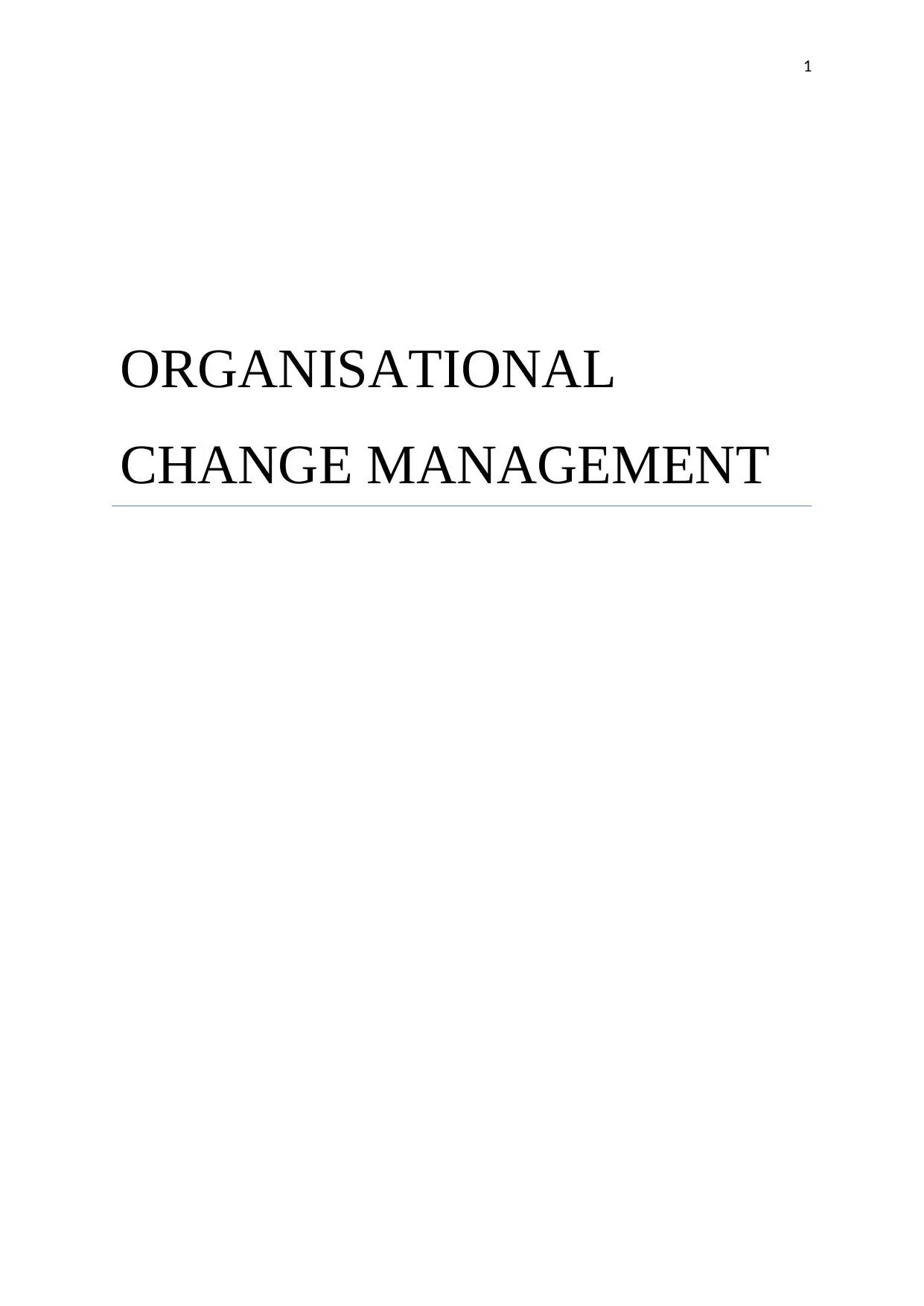
1
ORGANISATIONAL
CHANGE MANAGEMENT
ORGANISATIONAL
CHANGE MANAGEMENT
Paraphrase This Document
Need a fresh take? Get an instant paraphrase of this document with our AI Paraphraser
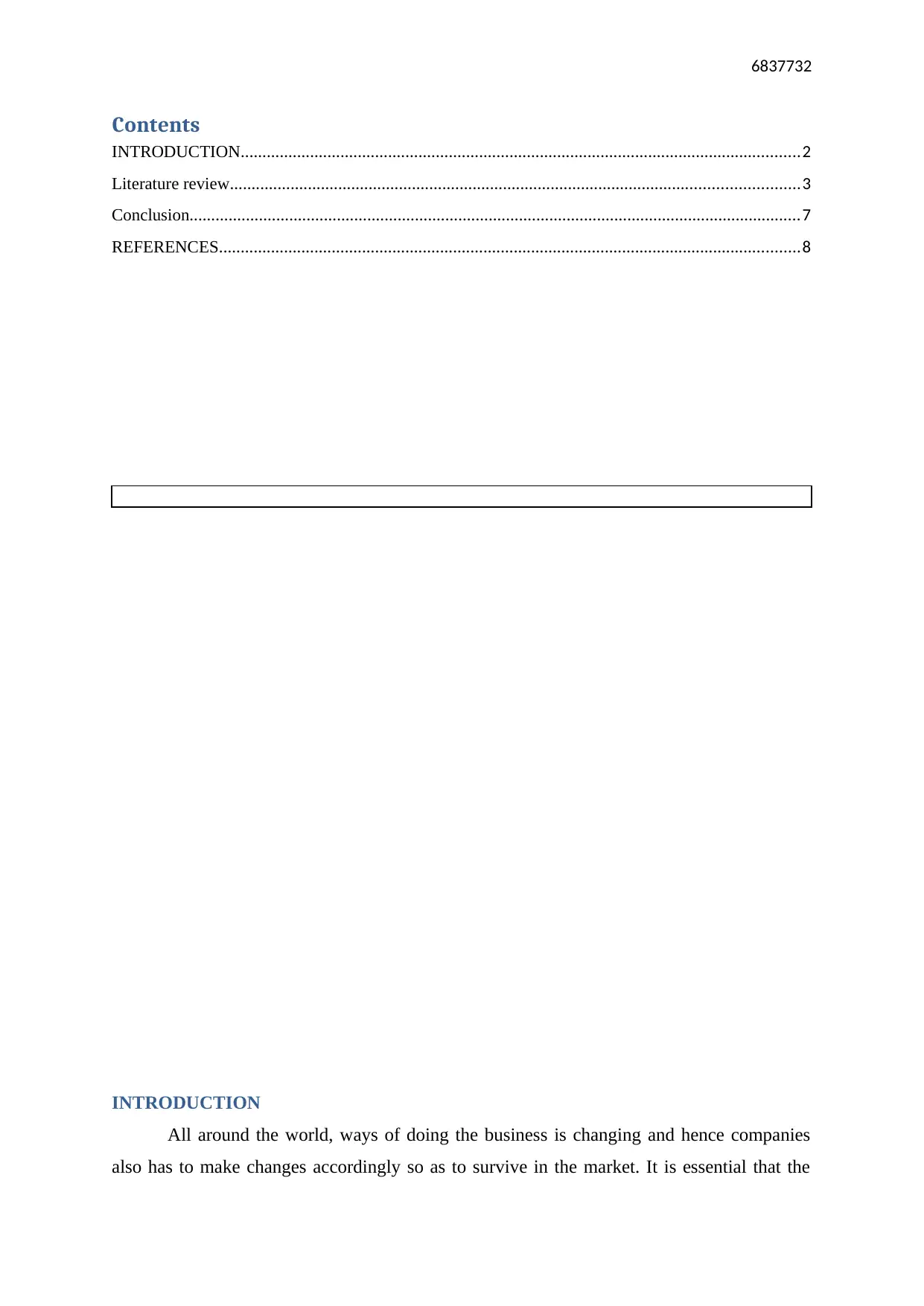
6837732
Contents
INTRODUCTION.................................................................................................................................2
Literature review...................................................................................................................................3
Conclusion.............................................................................................................................................7
REFERENCES......................................................................................................................................8
INTRODUCTION
All around the world, ways of doing the business is changing and hence companies
also has to make changes accordingly so as to survive in the market. It is essential that the
Contents
INTRODUCTION.................................................................................................................................2
Literature review...................................................................................................................................3
Conclusion.............................................................................................................................................7
REFERENCES......................................................................................................................................8
INTRODUCTION
All around the world, ways of doing the business is changing and hence companies
also has to make changes accordingly so as to survive in the market. It is essential that the
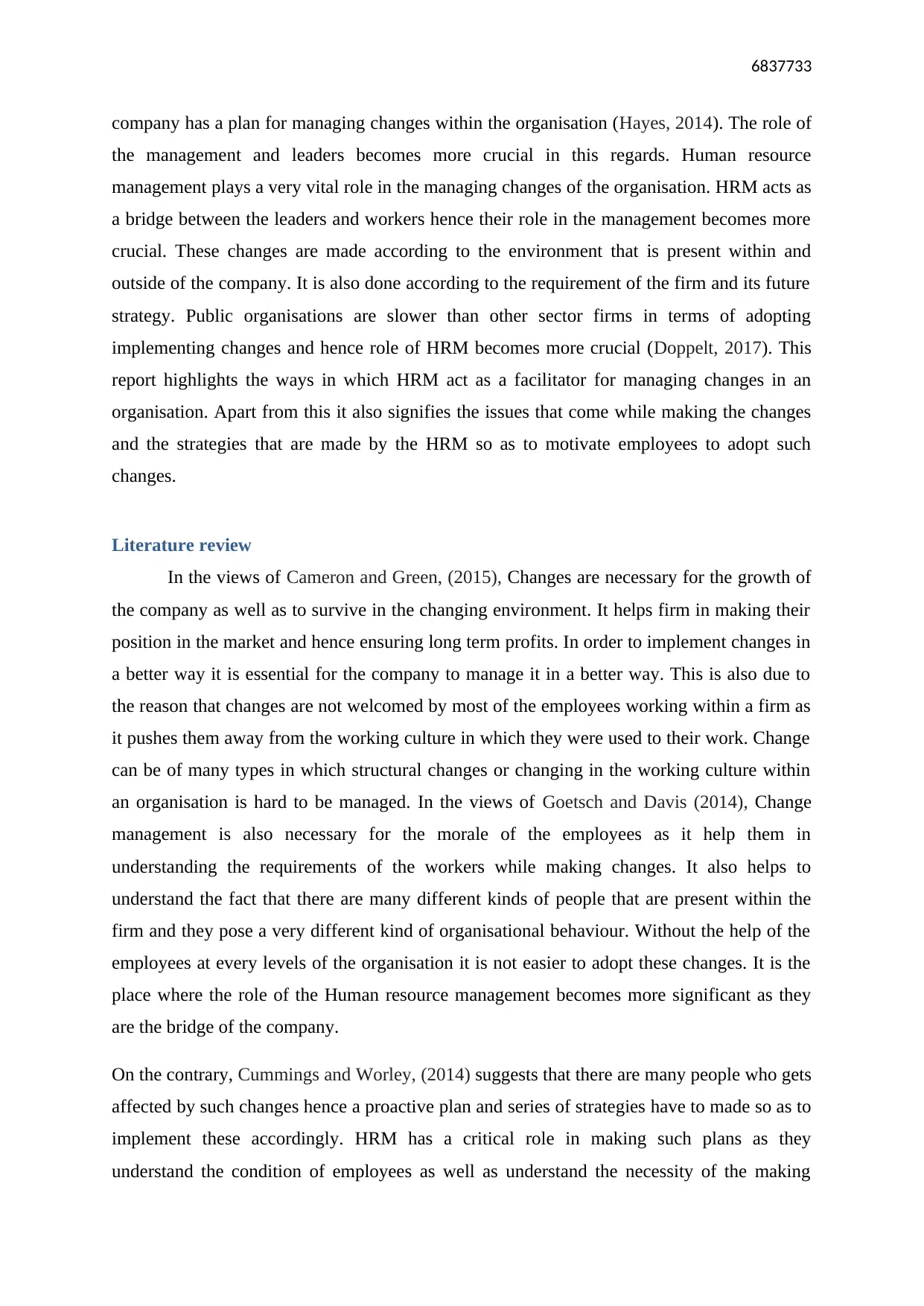
6837733
company has a plan for managing changes within the organisation (Hayes, 2014). The role of
the management and leaders becomes more crucial in this regards. Human resource
management plays a very vital role in the managing changes of the organisation. HRM acts as
a bridge between the leaders and workers hence their role in the management becomes more
crucial. These changes are made according to the environment that is present within and
outside of the company. It is also done according to the requirement of the firm and its future
strategy. Public organisations are slower than other sector firms in terms of adopting
implementing changes and hence role of HRM becomes more crucial (Doppelt, 2017). This
report highlights the ways in which HRM act as a facilitator for managing changes in an
organisation. Apart from this it also signifies the issues that come while making the changes
and the strategies that are made by the HRM so as to motivate employees to adopt such
changes.
Literature review
In the views of Cameron and Green, (2015), Changes are necessary for the growth of
the company as well as to survive in the changing environment. It helps firm in making their
position in the market and hence ensuring long term profits. In order to implement changes in
a better way it is essential for the company to manage it in a better way. This is also due to
the reason that changes are not welcomed by most of the employees working within a firm as
it pushes them away from the working culture in which they were used to their work. Change
can be of many types in which structural changes or changing in the working culture within
an organisation is hard to be managed. In the views of Goetsch and Davis (2014), Change
management is also necessary for the morale of the employees as it help them in
understanding the requirements of the workers while making changes. It also helps to
understand the fact that there are many different kinds of people that are present within the
firm and they pose a very different kind of organisational behaviour. Without the help of the
employees at every levels of the organisation it is not easier to adopt these changes. It is the
place where the role of the Human resource management becomes more significant as they
are the bridge of the company.
On the contrary, Cummings and Worley, (2014) suggests that there are many people who gets
affected by such changes hence a proactive plan and series of strategies have to made so as to
implement these accordingly. HRM has a critical role in making such plans as they
understand the condition of employees as well as understand the necessity of the making
company has a plan for managing changes within the organisation (Hayes, 2014). The role of
the management and leaders becomes more crucial in this regards. Human resource
management plays a very vital role in the managing changes of the organisation. HRM acts as
a bridge between the leaders and workers hence their role in the management becomes more
crucial. These changes are made according to the environment that is present within and
outside of the company. It is also done according to the requirement of the firm and its future
strategy. Public organisations are slower than other sector firms in terms of adopting
implementing changes and hence role of HRM becomes more crucial (Doppelt, 2017). This
report highlights the ways in which HRM act as a facilitator for managing changes in an
organisation. Apart from this it also signifies the issues that come while making the changes
and the strategies that are made by the HRM so as to motivate employees to adopt such
changes.
Literature review
In the views of Cameron and Green, (2015), Changes are necessary for the growth of
the company as well as to survive in the changing environment. It helps firm in making their
position in the market and hence ensuring long term profits. In order to implement changes in
a better way it is essential for the company to manage it in a better way. This is also due to
the reason that changes are not welcomed by most of the employees working within a firm as
it pushes them away from the working culture in which they were used to their work. Change
can be of many types in which structural changes or changing in the working culture within
an organisation is hard to be managed. In the views of Goetsch and Davis (2014), Change
management is also necessary for the morale of the employees as it help them in
understanding the requirements of the workers while making changes. It also helps to
understand the fact that there are many different kinds of people that are present within the
firm and they pose a very different kind of organisational behaviour. Without the help of the
employees at every levels of the organisation it is not easier to adopt these changes. It is the
place where the role of the Human resource management becomes more significant as they
are the bridge of the company.
On the contrary, Cummings and Worley, (2014) suggests that there are many people who gets
affected by such changes hence a proactive plan and series of strategies have to made so as to
implement these accordingly. HRM has a critical role in making such plans as they
understand the condition of employees as well as understand the necessity of the making
⊘ This is a preview!⊘
Do you want full access?
Subscribe today to unlock all pages.

Trusted by 1+ million students worldwide
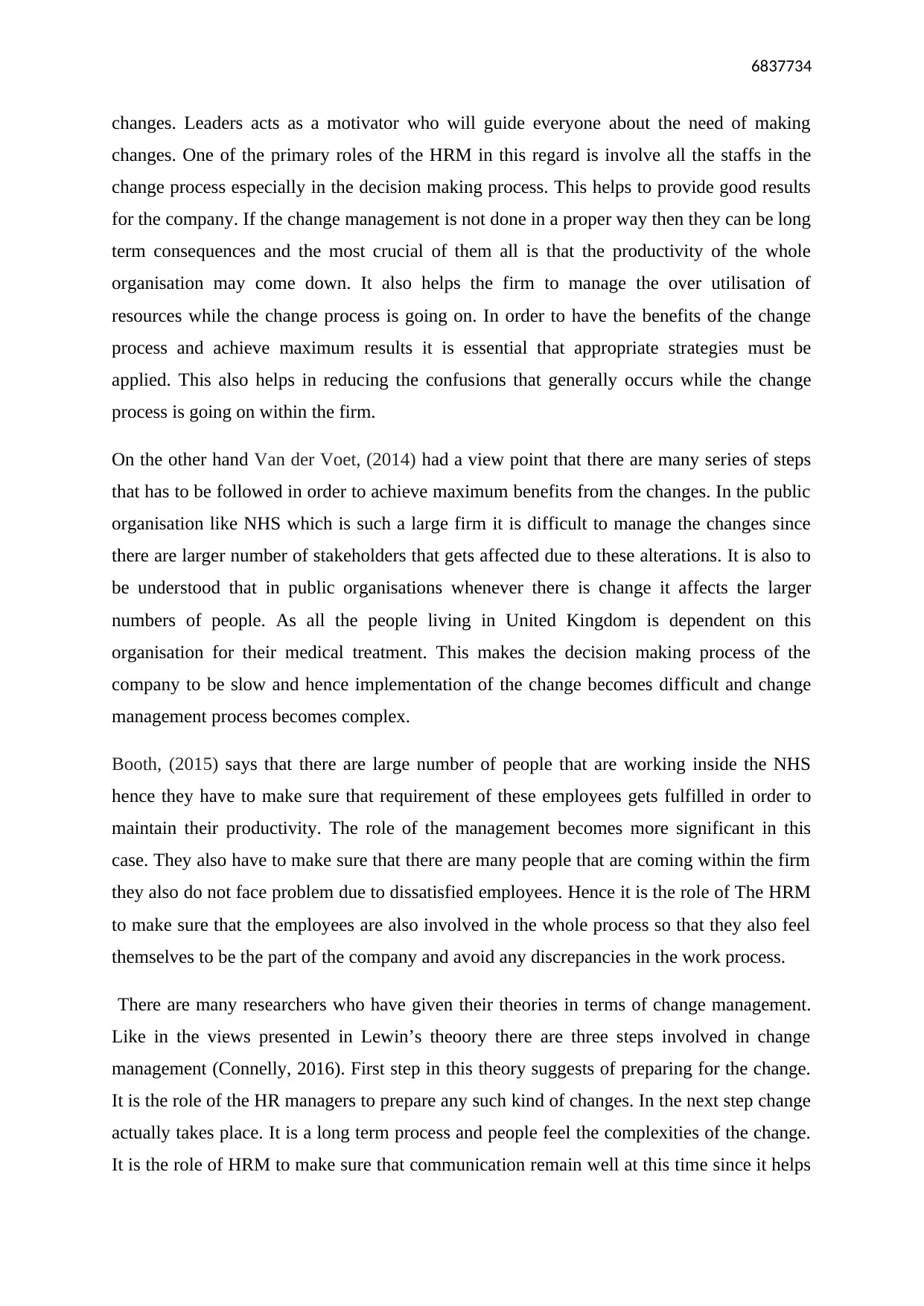
6837734
changes. Leaders acts as a motivator who will guide everyone about the need of making
changes. One of the primary roles of the HRM in this regard is involve all the staffs in the
change process especially in the decision making process. This helps to provide good results
for the company. If the change management is not done in a proper way then they can be long
term consequences and the most crucial of them all is that the productivity of the whole
organisation may come down. It also helps the firm to manage the over utilisation of
resources while the change process is going on. In order to have the benefits of the change
process and achieve maximum results it is essential that appropriate strategies must be
applied. This also helps in reducing the confusions that generally occurs while the change
process is going on within the firm.
On the other hand Van der Voet, (2014) had a view point that there are many series of steps
that has to be followed in order to achieve maximum benefits from the changes. In the public
organisation like NHS which is such a large firm it is difficult to manage the changes since
there are larger number of stakeholders that gets affected due to these alterations. It is also to
be understood that in public organisations whenever there is change it affects the larger
numbers of people. As all the people living in United Kingdom is dependent on this
organisation for their medical treatment. This makes the decision making process of the
company to be slow and hence implementation of the change becomes difficult and change
management process becomes complex.
Booth, (2015) says that there are large number of people that are working inside the NHS
hence they have to make sure that requirement of these employees gets fulfilled in order to
maintain their productivity. The role of the management becomes more significant in this
case. They also have to make sure that there are many people that are coming within the firm
they also do not face problem due to dissatisfied employees. Hence it is the role of The HRM
to make sure that the employees are also involved in the whole process so that they also feel
themselves to be the part of the company and avoid any discrepancies in the work process.
There are many researchers who have given their theories in terms of change management.
Like in the views presented in Lewin’s theoory there are three steps involved in change
management (Connelly, 2016). First step in this theory suggests of preparing for the change.
It is the role of the HR managers to prepare any such kind of changes. In the next step change
actually takes place. It is a long term process and people feel the complexities of the change.
It is the role of HRM to make sure that communication remain well at this time since it helps
changes. Leaders acts as a motivator who will guide everyone about the need of making
changes. One of the primary roles of the HRM in this regard is involve all the staffs in the
change process especially in the decision making process. This helps to provide good results
for the company. If the change management is not done in a proper way then they can be long
term consequences and the most crucial of them all is that the productivity of the whole
organisation may come down. It also helps the firm to manage the over utilisation of
resources while the change process is going on. In order to have the benefits of the change
process and achieve maximum results it is essential that appropriate strategies must be
applied. This also helps in reducing the confusions that generally occurs while the change
process is going on within the firm.
On the other hand Van der Voet, (2014) had a view point that there are many series of steps
that has to be followed in order to achieve maximum benefits from the changes. In the public
organisation like NHS which is such a large firm it is difficult to manage the changes since
there are larger number of stakeholders that gets affected due to these alterations. It is also to
be understood that in public organisations whenever there is change it affects the larger
numbers of people. As all the people living in United Kingdom is dependent on this
organisation for their medical treatment. This makes the decision making process of the
company to be slow and hence implementation of the change becomes difficult and change
management process becomes complex.
Booth, (2015) says that there are large number of people that are working inside the NHS
hence they have to make sure that requirement of these employees gets fulfilled in order to
maintain their productivity. The role of the management becomes more significant in this
case. They also have to make sure that there are many people that are coming within the firm
they also do not face problem due to dissatisfied employees. Hence it is the role of The HRM
to make sure that the employees are also involved in the whole process so that they also feel
themselves to be the part of the company and avoid any discrepancies in the work process.
There are many researchers who have given their theories in terms of change management.
Like in the views presented in Lewin’s theoory there are three steps involved in change
management (Connelly, 2016). First step in this theory suggests of preparing for the change.
It is the role of the HR managers to prepare any such kind of changes. In the next step change
actually takes place. It is a long term process and people feel the complexities of the change.
It is the role of HRM to make sure that communication remain well at this time since it helps
Paraphrase This Document
Need a fresh take? Get an instant paraphrase of this document with our AI Paraphraser
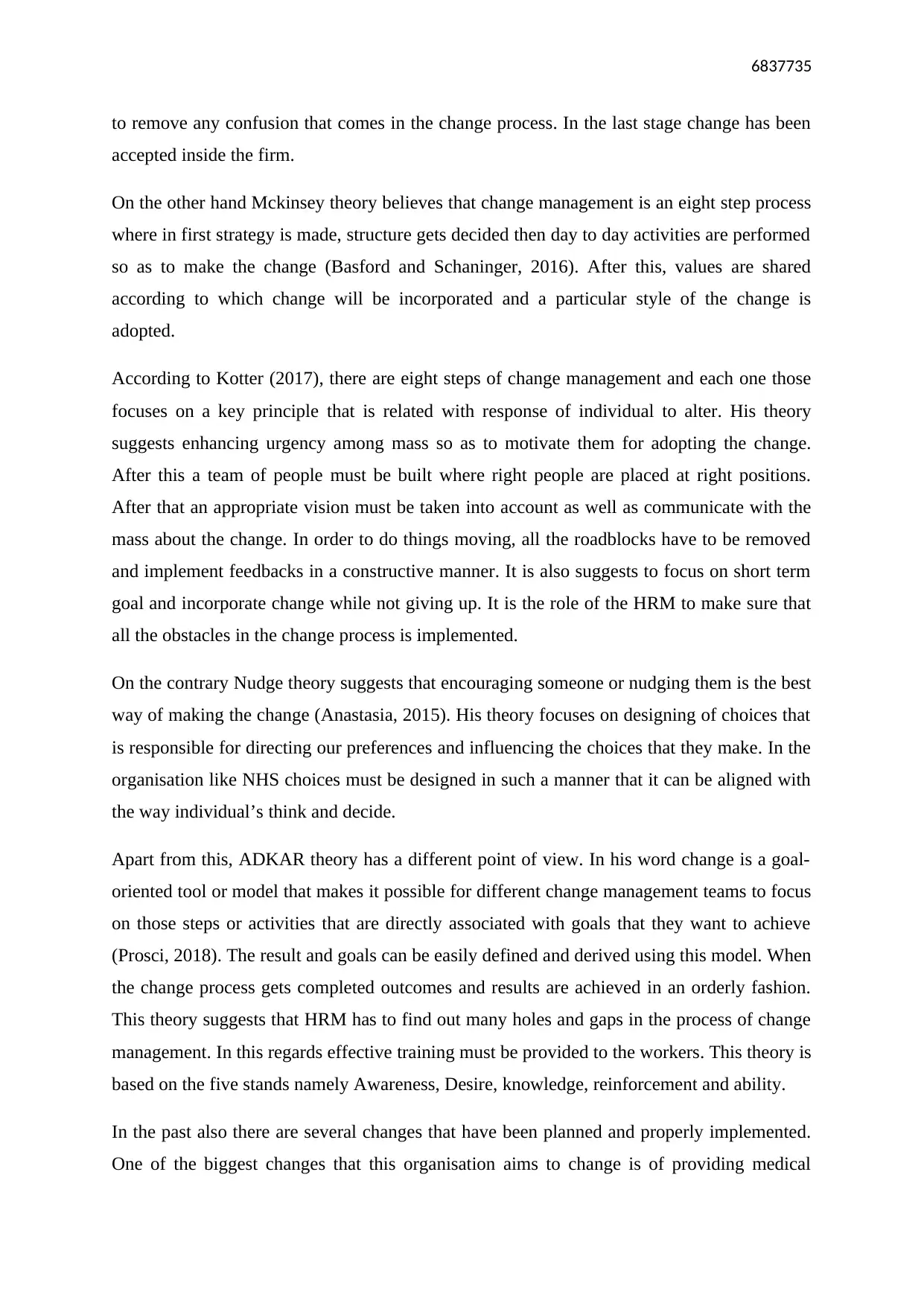
6837735
to remove any confusion that comes in the change process. In the last stage change has been
accepted inside the firm.
On the other hand Mckinsey theory believes that change management is an eight step process
where in first strategy is made, structure gets decided then day to day activities are performed
so as to make the change (Basford and Schaninger, 2016). After this, values are shared
according to which change will be incorporated and a particular style of the change is
adopted.
According to Kotter (2017), there are eight steps of change management and each one those
focuses on a key principle that is related with response of individual to alter. His theory
suggests enhancing urgency among mass so as to motivate them for adopting the change.
After this a team of people must be built where right people are placed at right positions.
After that an appropriate vision must be taken into account as well as communicate with the
mass about the change. In order to do things moving, all the roadblocks have to be removed
and implement feedbacks in a constructive manner. It is also suggests to focus on short term
goal and incorporate change while not giving up. It is the role of the HRM to make sure that
all the obstacles in the change process is implemented.
On the contrary Nudge theory suggests that encouraging someone or nudging them is the best
way of making the change (Anastasia, 2015). His theory focuses on designing of choices that
is responsible for directing our preferences and influencing the choices that they make. In the
organisation like NHS choices must be designed in such a manner that it can be aligned with
the way individual’s think and decide.
Apart from this, ADKAR theory has a different point of view. In his word change is a goal-
oriented tool or model that makes it possible for different change management teams to focus
on those steps or activities that are directly associated with goals that they want to achieve
(Prosci, 2018). The result and goals can be easily defined and derived using this model. When
the change process gets completed outcomes and results are achieved in an orderly fashion.
This theory suggests that HRM has to find out many holes and gaps in the process of change
management. In this regards effective training must be provided to the workers. This theory is
based on the five stands namely Awareness, Desire, knowledge, reinforcement and ability.
In the past also there are several changes that have been planned and properly implemented.
One of the biggest changes that this organisation aims to change is of providing medical
to remove any confusion that comes in the change process. In the last stage change has been
accepted inside the firm.
On the other hand Mckinsey theory believes that change management is an eight step process
where in first strategy is made, structure gets decided then day to day activities are performed
so as to make the change (Basford and Schaninger, 2016). After this, values are shared
according to which change will be incorporated and a particular style of the change is
adopted.
According to Kotter (2017), there are eight steps of change management and each one those
focuses on a key principle that is related with response of individual to alter. His theory
suggests enhancing urgency among mass so as to motivate them for adopting the change.
After this a team of people must be built where right people are placed at right positions.
After that an appropriate vision must be taken into account as well as communicate with the
mass about the change. In order to do things moving, all the roadblocks have to be removed
and implement feedbacks in a constructive manner. It is also suggests to focus on short term
goal and incorporate change while not giving up. It is the role of the HRM to make sure that
all the obstacles in the change process is implemented.
On the contrary Nudge theory suggests that encouraging someone or nudging them is the best
way of making the change (Anastasia, 2015). His theory focuses on designing of choices that
is responsible for directing our preferences and influencing the choices that they make. In the
organisation like NHS choices must be designed in such a manner that it can be aligned with
the way individual’s think and decide.
Apart from this, ADKAR theory has a different point of view. In his word change is a goal-
oriented tool or model that makes it possible for different change management teams to focus
on those steps or activities that are directly associated with goals that they want to achieve
(Prosci, 2018). The result and goals can be easily defined and derived using this model. When
the change process gets completed outcomes and results are achieved in an orderly fashion.
This theory suggests that HRM has to find out many holes and gaps in the process of change
management. In this regards effective training must be provided to the workers. This theory is
based on the five stands namely Awareness, Desire, knowledge, reinforcement and ability.
In the past also there are several changes that have been planned and properly implemented.
One of the biggest changes that this organisation aims to change is of providing medical
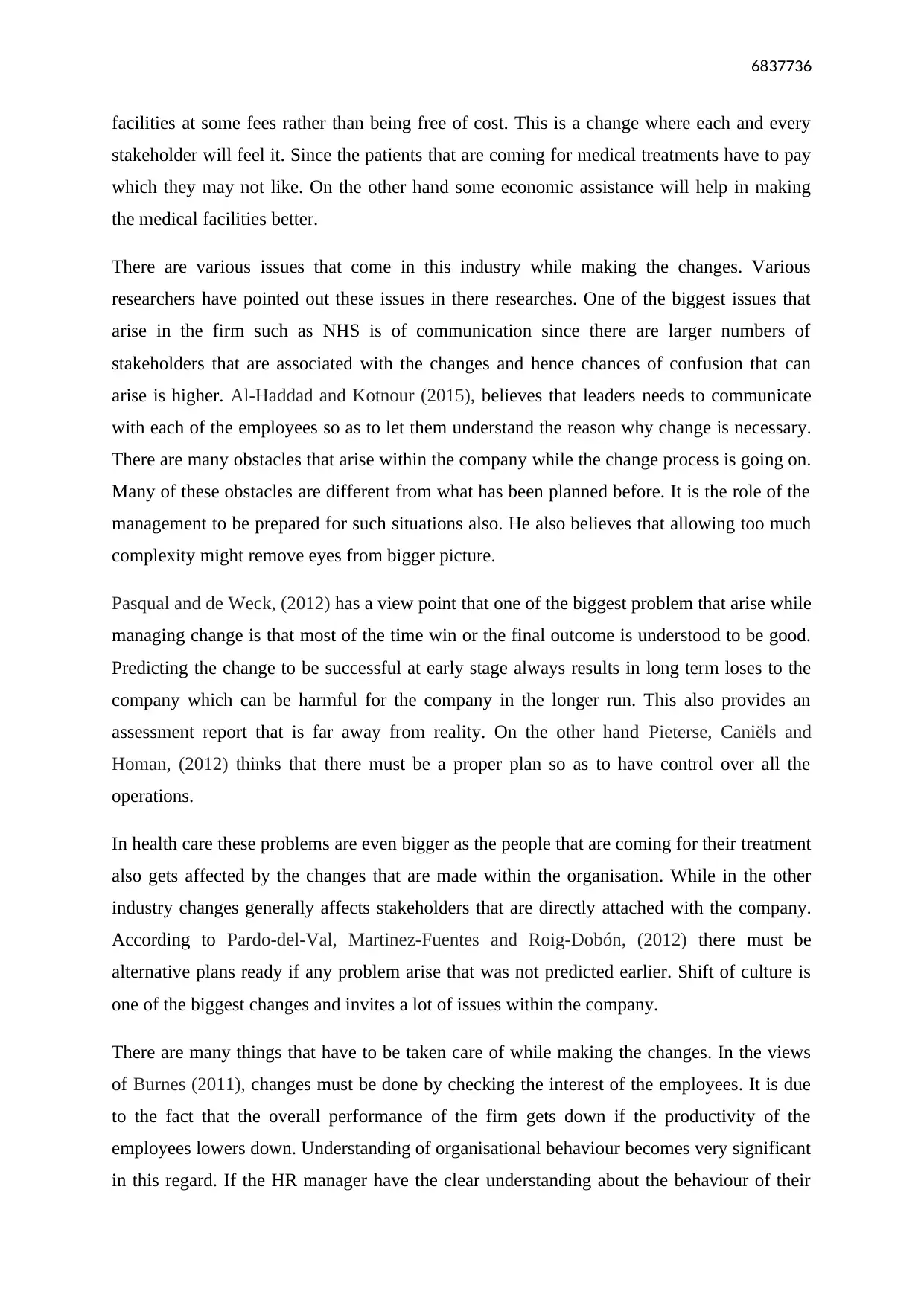
6837736
facilities at some fees rather than being free of cost. This is a change where each and every
stakeholder will feel it. Since the patients that are coming for medical treatments have to pay
which they may not like. On the other hand some economic assistance will help in making
the medical facilities better.
There are various issues that come in this industry while making the changes. Various
researchers have pointed out these issues in there researches. One of the biggest issues that
arise in the firm such as NHS is of communication since there are larger numbers of
stakeholders that are associated with the changes and hence chances of confusion that can
arise is higher. Al-Haddad and Kotnour (2015), believes that leaders needs to communicate
with each of the employees so as to let them understand the reason why change is necessary.
There are many obstacles that arise within the company while the change process is going on.
Many of these obstacles are different from what has been planned before. It is the role of the
management to be prepared for such situations also. He also believes that allowing too much
complexity might remove eyes from bigger picture.
Pasqual and de Weck, (2012) has a view point that one of the biggest problem that arise while
managing change is that most of the time win or the final outcome is understood to be good.
Predicting the change to be successful at early stage always results in long term loses to the
company which can be harmful for the company in the longer run. This also provides an
assessment report that is far away from reality. On the other hand Pieterse, Caniëls and
Homan, (2012) thinks that there must be a proper plan so as to have control over all the
operations.
In health care these problems are even bigger as the people that are coming for their treatment
also gets affected by the changes that are made within the organisation. While in the other
industry changes generally affects stakeholders that are directly attached with the company.
According to Pardo-del-Val, Martinez-Fuentes and Roig-Dobón, (2012) there must be
alternative plans ready if any problem arise that was not predicted earlier. Shift of culture is
one of the biggest changes and invites a lot of issues within the company.
There are many things that have to be taken care of while making the changes. In the views
of Burnes (2011), changes must be done by checking the interest of the employees. It is due
to the fact that the overall performance of the firm gets down if the productivity of the
employees lowers down. Understanding of organisational behaviour becomes very significant
in this regard. If the HR manager have the clear understanding about the behaviour of their
facilities at some fees rather than being free of cost. This is a change where each and every
stakeholder will feel it. Since the patients that are coming for medical treatments have to pay
which they may not like. On the other hand some economic assistance will help in making
the medical facilities better.
There are various issues that come in this industry while making the changes. Various
researchers have pointed out these issues in there researches. One of the biggest issues that
arise in the firm such as NHS is of communication since there are larger numbers of
stakeholders that are associated with the changes and hence chances of confusion that can
arise is higher. Al-Haddad and Kotnour (2015), believes that leaders needs to communicate
with each of the employees so as to let them understand the reason why change is necessary.
There are many obstacles that arise within the company while the change process is going on.
Many of these obstacles are different from what has been planned before. It is the role of the
management to be prepared for such situations also. He also believes that allowing too much
complexity might remove eyes from bigger picture.
Pasqual and de Weck, (2012) has a view point that one of the biggest problem that arise while
managing change is that most of the time win or the final outcome is understood to be good.
Predicting the change to be successful at early stage always results in long term loses to the
company which can be harmful for the company in the longer run. This also provides an
assessment report that is far away from reality. On the other hand Pieterse, Caniëls and
Homan, (2012) thinks that there must be a proper plan so as to have control over all the
operations.
In health care these problems are even bigger as the people that are coming for their treatment
also gets affected by the changes that are made within the organisation. While in the other
industry changes generally affects stakeholders that are directly attached with the company.
According to Pardo-del-Val, Martinez-Fuentes and Roig-Dobón, (2012) there must be
alternative plans ready if any problem arise that was not predicted earlier. Shift of culture is
one of the biggest changes and invites a lot of issues within the company.
There are many things that have to be taken care of while making the changes. In the views
of Burnes (2011), changes must be done by checking the interest of the employees. It is due
to the fact that the overall performance of the firm gets down if the productivity of the
employees lowers down. Understanding of organisational behaviour becomes very significant
in this regard. If the HR manager have the clear understanding about the behaviour of their
⊘ This is a preview!⊘
Do you want full access?
Subscribe today to unlock all pages.

Trusted by 1+ million students worldwide
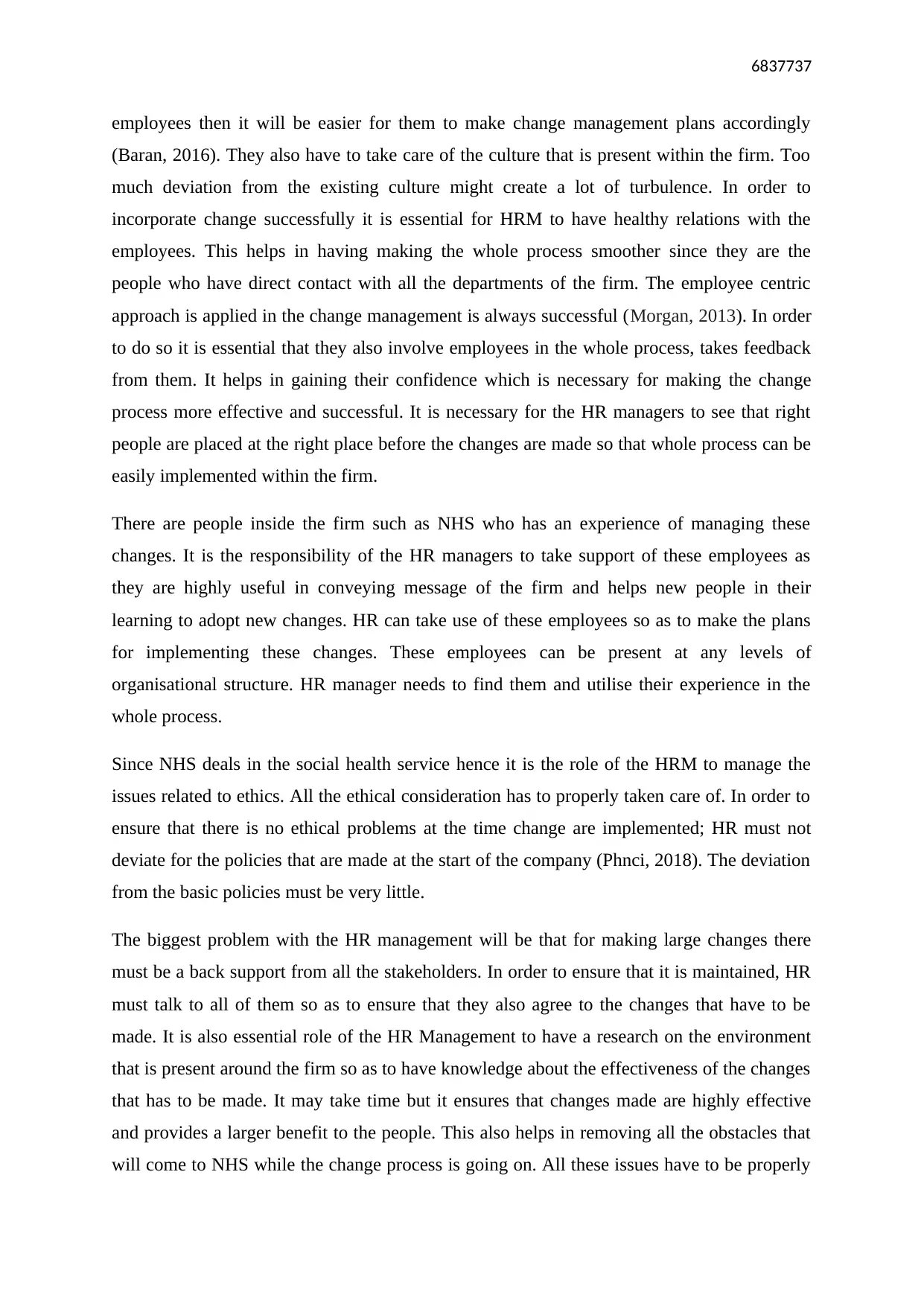
6837737
employees then it will be easier for them to make change management plans accordingly
(Baran, 2016). They also have to take care of the culture that is present within the firm. Too
much deviation from the existing culture might create a lot of turbulence. In order to
incorporate change successfully it is essential for HRM to have healthy relations with the
employees. This helps in having making the whole process smoother since they are the
people who have direct contact with all the departments of the firm. The employee centric
approach is applied in the change management is always successful (Morgan, 2013). In order
to do so it is essential that they also involve employees in the whole process, takes feedback
from them. It helps in gaining their confidence which is necessary for making the change
process more effective and successful. It is necessary for the HR managers to see that right
people are placed at the right place before the changes are made so that whole process can be
easily implemented within the firm.
There are people inside the firm such as NHS who has an experience of managing these
changes. It is the responsibility of the HR managers to take support of these employees as
they are highly useful in conveying message of the firm and helps new people in their
learning to adopt new changes. HR can take use of these employees so as to make the plans
for implementing these changes. These employees can be present at any levels of
organisational structure. HR manager needs to find them and utilise their experience in the
whole process.
Since NHS deals in the social health service hence it is the role of the HRM to manage the
issues related to ethics. All the ethical consideration has to properly taken care of. In order to
ensure that there is no ethical problems at the time change are implemented; HR must not
deviate for the policies that are made at the start of the company (Phnci, 2018). The deviation
from the basic policies must be very little.
The biggest problem with the HR management will be that for making large changes there
must be a back support from all the stakeholders. In order to ensure that it is maintained, HR
must talk to all of them so as to ensure that they also agree to the changes that have to be
made. It is also essential role of the HR Management to have a research on the environment
that is present around the firm so as to have knowledge about the effectiveness of the changes
that has to be made. It may take time but it ensures that changes made are highly effective
and provides a larger benefit to the people. This also helps in removing all the obstacles that
will come to NHS while the change process is going on. All these issues have to be properly
employees then it will be easier for them to make change management plans accordingly
(Baran, 2016). They also have to take care of the culture that is present within the firm. Too
much deviation from the existing culture might create a lot of turbulence. In order to
incorporate change successfully it is essential for HRM to have healthy relations with the
employees. This helps in having making the whole process smoother since they are the
people who have direct contact with all the departments of the firm. The employee centric
approach is applied in the change management is always successful (Morgan, 2013). In order
to do so it is essential that they also involve employees in the whole process, takes feedback
from them. It helps in gaining their confidence which is necessary for making the change
process more effective and successful. It is necessary for the HR managers to see that right
people are placed at the right place before the changes are made so that whole process can be
easily implemented within the firm.
There are people inside the firm such as NHS who has an experience of managing these
changes. It is the responsibility of the HR managers to take support of these employees as
they are highly useful in conveying message of the firm and helps new people in their
learning to adopt new changes. HR can take use of these employees so as to make the plans
for implementing these changes. These employees can be present at any levels of
organisational structure. HR manager needs to find them and utilise their experience in the
whole process.
Since NHS deals in the social health service hence it is the role of the HRM to manage the
issues related to ethics. All the ethical consideration has to properly taken care of. In order to
ensure that there is no ethical problems at the time change are implemented; HR must not
deviate for the policies that are made at the start of the company (Phnci, 2018). The deviation
from the basic policies must be very little.
The biggest problem with the HR management will be that for making large changes there
must be a back support from all the stakeholders. In order to ensure that it is maintained, HR
must talk to all of them so as to ensure that they also agree to the changes that have to be
made. It is also essential role of the HR Management to have a research on the environment
that is present around the firm so as to have knowledge about the effectiveness of the changes
that has to be made. It may take time but it ensures that changes made are highly effective
and provides a larger benefit to the people. This also helps in removing all the obstacles that
will come to NHS while the change process is going on. All these issues have to be properly
Paraphrase This Document
Need a fresh take? Get an instant paraphrase of this document with our AI Paraphraser
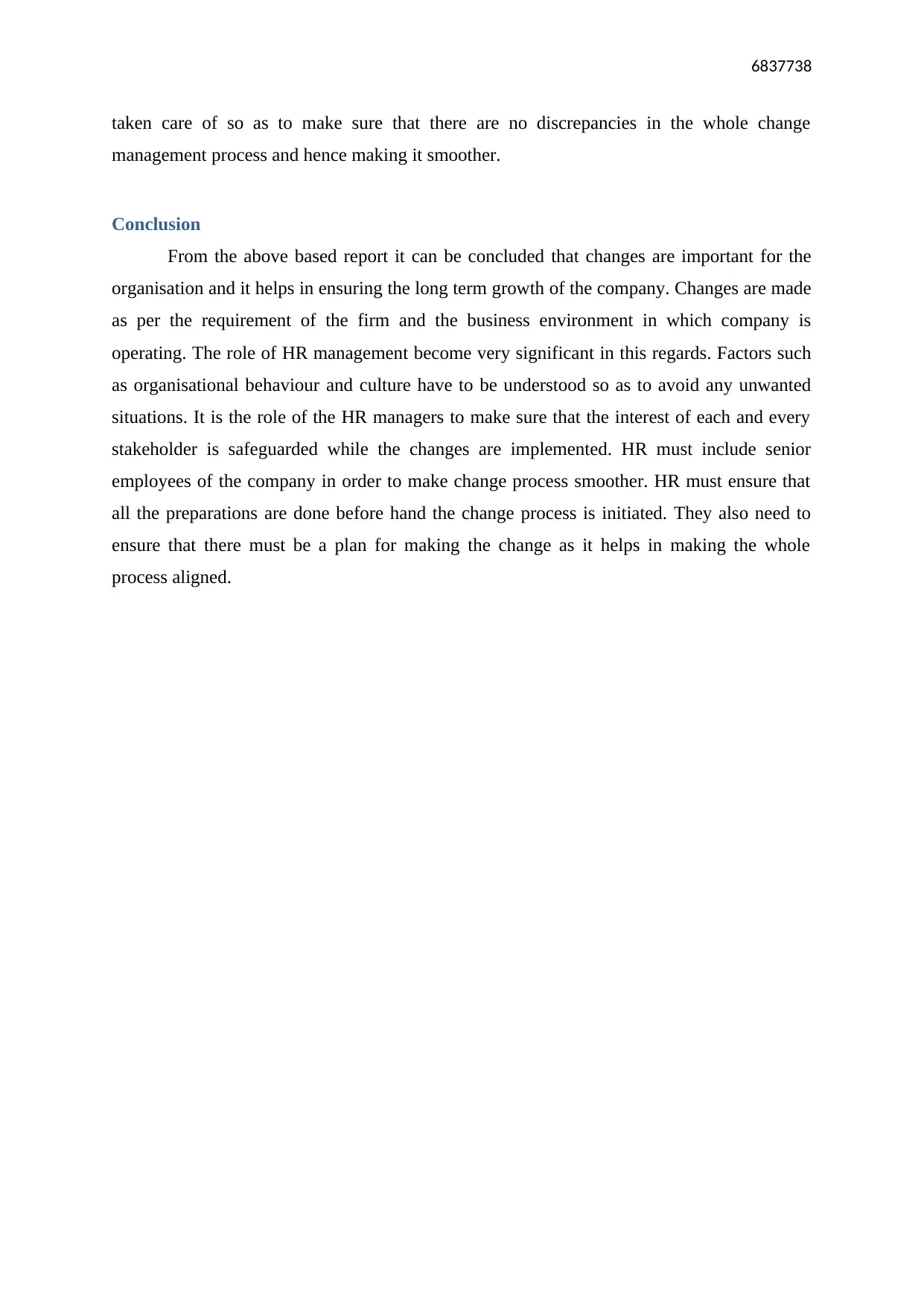
6837738
taken care of so as to make sure that there are no discrepancies in the whole change
management process and hence making it smoother.
Conclusion
From the above based report it can be concluded that changes are important for the
organisation and it helps in ensuring the long term growth of the company. Changes are made
as per the requirement of the firm and the business environment in which company is
operating. The role of HR management become very significant in this regards. Factors such
as organisational behaviour and culture have to be understood so as to avoid any unwanted
situations. It is the role of the HR managers to make sure that the interest of each and every
stakeholder is safeguarded while the changes are implemented. HR must include senior
employees of the company in order to make change process smoother. HR must ensure that
all the preparations are done before hand the change process is initiated. They also need to
ensure that there must be a plan for making the change as it helps in making the whole
process aligned.
taken care of so as to make sure that there are no discrepancies in the whole change
management process and hence making it smoother.
Conclusion
From the above based report it can be concluded that changes are important for the
organisation and it helps in ensuring the long term growth of the company. Changes are made
as per the requirement of the firm and the business environment in which company is
operating. The role of HR management become very significant in this regards. Factors such
as organisational behaviour and culture have to be understood so as to avoid any unwanted
situations. It is the role of the HR managers to make sure that the interest of each and every
stakeholder is safeguarded while the changes are implemented. HR must include senior
employees of the company in order to make change process smoother. HR must ensure that
all the preparations are done before hand the change process is initiated. They also need to
ensure that there must be a plan for making the change as it helps in making the whole
process aligned.
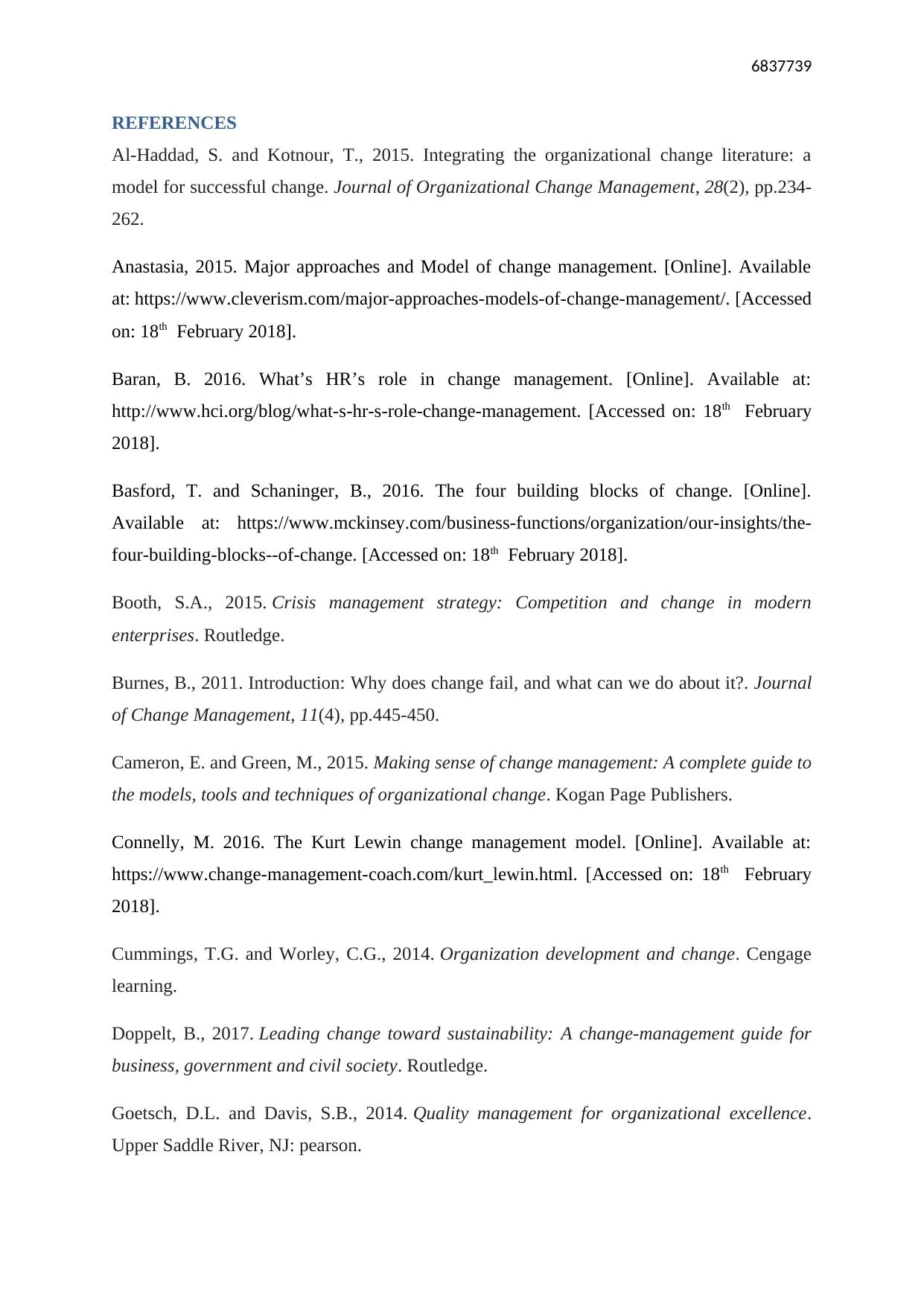
6837739
REFERENCES
Al-Haddad, S. and Kotnour, T., 2015. Integrating the organizational change literature: a
model for successful change. Journal of Organizational Change Management, 28(2), pp.234-
262.
Anastasia, 2015. Major approaches and Model of change management. [Online]. Available
at: https://www.cleverism.com/major-approaches-models-of-change-management/. [Accessed
on: 18th February 2018].
Baran, B. 2016. What’s HR’s role in change management. [Online]. Available at:
http://www.hci.org/blog/what-s-hr-s-role-change-management. [Accessed on: 18th February
2018].
Basford, T. and Schaninger, B., 2016. The four building blocks of change. [Online].
Available at: https://www.mckinsey.com/business-functions/organization/our-insights/the-
four-building-blocks--of-change. [Accessed on: 18th February 2018].
Booth, S.A., 2015. Crisis management strategy: Competition and change in modern
enterprises. Routledge.
Burnes, B., 2011. Introduction: Why does change fail, and what can we do about it?. Journal
of Change Management, 11(4), pp.445-450.
Cameron, E. and Green, M., 2015. Making sense of change management: A complete guide to
the models, tools and techniques of organizational change. Kogan Page Publishers.
Connelly, M. 2016. The Kurt Lewin change management model. [Online]. Available at:
https://www.change-management-coach.com/kurt_lewin.html. [Accessed on: 18th February
2018].
Cummings, T.G. and Worley, C.G., 2014. Organization development and change. Cengage
learning.
Doppelt, B., 2017. Leading change toward sustainability: A change-management guide for
business, government and civil society. Routledge.
Goetsch, D.L. and Davis, S.B., 2014. Quality management for organizational excellence.
Upper Saddle River, NJ: pearson.
REFERENCES
Al-Haddad, S. and Kotnour, T., 2015. Integrating the organizational change literature: a
model for successful change. Journal of Organizational Change Management, 28(2), pp.234-
262.
Anastasia, 2015. Major approaches and Model of change management. [Online]. Available
at: https://www.cleverism.com/major-approaches-models-of-change-management/. [Accessed
on: 18th February 2018].
Baran, B. 2016. What’s HR’s role in change management. [Online]. Available at:
http://www.hci.org/blog/what-s-hr-s-role-change-management. [Accessed on: 18th February
2018].
Basford, T. and Schaninger, B., 2016. The four building blocks of change. [Online].
Available at: https://www.mckinsey.com/business-functions/organization/our-insights/the-
four-building-blocks--of-change. [Accessed on: 18th February 2018].
Booth, S.A., 2015. Crisis management strategy: Competition and change in modern
enterprises. Routledge.
Burnes, B., 2011. Introduction: Why does change fail, and what can we do about it?. Journal
of Change Management, 11(4), pp.445-450.
Cameron, E. and Green, M., 2015. Making sense of change management: A complete guide to
the models, tools and techniques of organizational change. Kogan Page Publishers.
Connelly, M. 2016. The Kurt Lewin change management model. [Online]. Available at:
https://www.change-management-coach.com/kurt_lewin.html. [Accessed on: 18th February
2018].
Cummings, T.G. and Worley, C.G., 2014. Organization development and change. Cengage
learning.
Doppelt, B., 2017. Leading change toward sustainability: A change-management guide for
business, government and civil society. Routledge.
Goetsch, D.L. and Davis, S.B., 2014. Quality management for organizational excellence.
Upper Saddle River, NJ: pearson.
⊘ This is a preview!⊘
Do you want full access?
Subscribe today to unlock all pages.

Trusted by 1+ million students worldwide
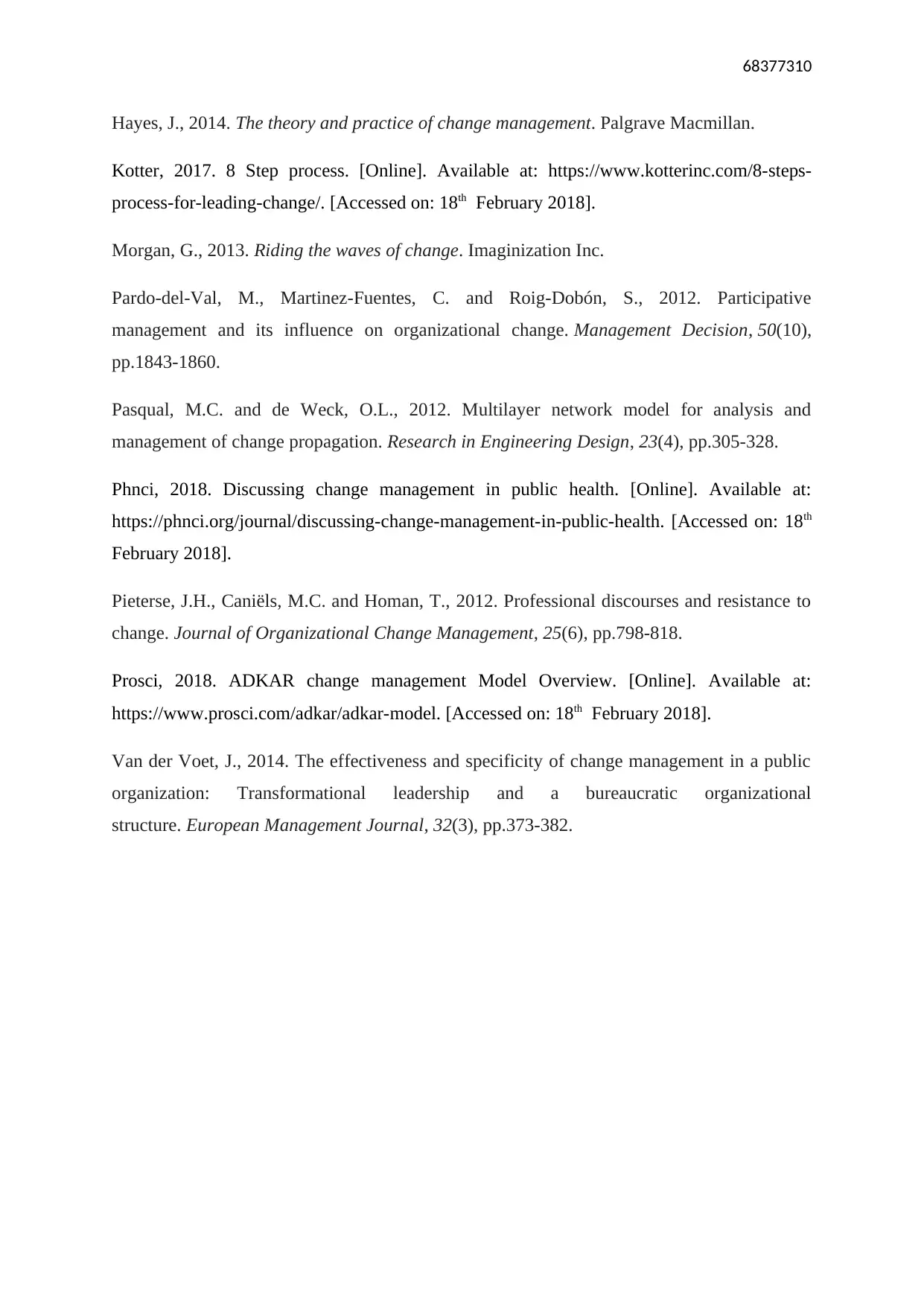
68377310
Hayes, J., 2014. The theory and practice of change management. Palgrave Macmillan.
Kotter, 2017. 8 Step process. [Online]. Available at: https://www.kotterinc.com/8-steps-
process-for-leading-change/. [Accessed on: 18th February 2018].
Morgan, G., 2013. Riding the waves of change. Imaginization Inc.
Pardo-del-Val, M., Martinez-Fuentes, C. and Roig-Dobón, S., 2012. Participative
management and its influence on organizational change. Management Decision, 50(10),
pp.1843-1860.
Pasqual, M.C. and de Weck, O.L., 2012. Multilayer network model for analysis and
management of change propagation. Research in Engineering Design, 23(4), pp.305-328.
Phnci, 2018. Discussing change management in public health. [Online]. Available at:
https://phnci.org/journal/discussing-change-management-in-public-health. [Accessed on: 18th
February 2018].
Pieterse, J.H., Caniëls, M.C. and Homan, T., 2012. Professional discourses and resistance to
change. Journal of Organizational Change Management, 25(6), pp.798-818.
Prosci, 2018. ADKAR change management Model Overview. [Online]. Available at:
https://www.prosci.com/adkar/adkar-model. [Accessed on: 18th February 2018].
Van der Voet, J., 2014. The effectiveness and specificity of change management in a public
organization: Transformational leadership and a bureaucratic organizational
structure. European Management Journal, 32(3), pp.373-382.
Hayes, J., 2014. The theory and practice of change management. Palgrave Macmillan.
Kotter, 2017. 8 Step process. [Online]. Available at: https://www.kotterinc.com/8-steps-
process-for-leading-change/. [Accessed on: 18th February 2018].
Morgan, G., 2013. Riding the waves of change. Imaginization Inc.
Pardo-del-Val, M., Martinez-Fuentes, C. and Roig-Dobón, S., 2012. Participative
management and its influence on organizational change. Management Decision, 50(10),
pp.1843-1860.
Pasqual, M.C. and de Weck, O.L., 2012. Multilayer network model for analysis and
management of change propagation. Research in Engineering Design, 23(4), pp.305-328.
Phnci, 2018. Discussing change management in public health. [Online]. Available at:
https://phnci.org/journal/discussing-change-management-in-public-health. [Accessed on: 18th
February 2018].
Pieterse, J.H., Caniëls, M.C. and Homan, T., 2012. Professional discourses and resistance to
change. Journal of Organizational Change Management, 25(6), pp.798-818.
Prosci, 2018. ADKAR change management Model Overview. [Online]. Available at:
https://www.prosci.com/adkar/adkar-model. [Accessed on: 18th February 2018].
Van der Voet, J., 2014. The effectiveness and specificity of change management in a public
organization: Transformational leadership and a bureaucratic organizational
structure. European Management Journal, 32(3), pp.373-382.
1 out of 10
Related Documents
Your All-in-One AI-Powered Toolkit for Academic Success.
+13062052269
info@desklib.com
Available 24*7 on WhatsApp / Email
![[object Object]](/_next/static/media/star-bottom.7253800d.svg)
Unlock your academic potential
Copyright © 2020–2025 A2Z Services. All Rights Reserved. Developed and managed by ZUCOL.





